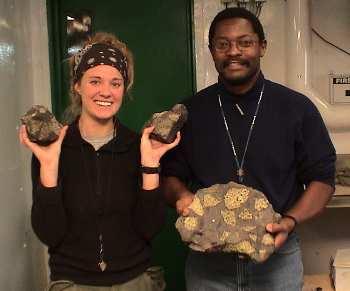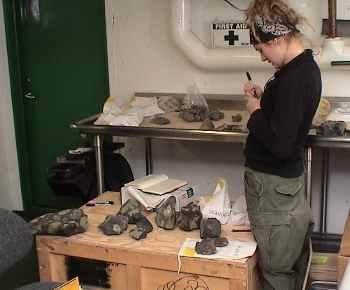28 January, 2004
For Sam Mukasa and Jill Van Tongeren from the University of Michigan
it was a good day to catch up on some back work. Earlier in the
cruise Sam and Jill with the help of many of the scientists, marine
staff and crew had collected rock samples at Franklin Island. Over
the past couple of days Sam had been looking over the collection
formalizing a method to catalog each sample so that when he returned
to Michigan he would have an inventory of the location and geologic
feature where each sample was taken.
Sam had washed all of the rock samples that he had collected and Jill
was about to begin washing all of those that she had taken. As we
talked, he and Jill labeled each sample with paint pen and permanent
marker with an alphanumeric label. Each sample was then placed in a
canvas bag, with the identification written directly on the bag and
on a tag attached to the bag.
Sam recounted a story about some rock samples that had been collected
by many geologists in many areas over many years that had been mixed
together as the result of an earthquake in California. The samples
had been placed in bags, but the rocks had not been labeled directly.
During the course of the quake, the shelves that the rocks had been
stored on broke and the samples all came crashing to the floor. This
would not have been a problem, but the samples were collected over so
many years that most of the collection bags were old and brittle and
broke when the samples hit the floor. When the geologists began
attempted to reorganize and identify the samples, they could not.
They were left with a pile of interesting rocks.
In addition to the collection bags and direct labels, Sam and Jill
had also recorded information about each sample in a field journal,
and many of the more unusual samples were photographed as well.
When they get the samples back to Michigan, they will make thin
sections of the rocks to look at their structure under the
microscope. Their emphasis will be on looking at the chemical
composition of the rocks looking in parcticular at trace radioisotopes
that will help them to date the age of the rocks. From this isotope
data they can age the flows from which they samples were originally
taken, producing a timeline for the volcanic events that formed
Franklin Island. They will be very interested in the magma nodules.
These nodules contain crystals that are formed by minerals that cool
more rapidly than the surrounding rock. The most common mineral that
they will find is Olivine. If the nodules that are exposed to the
elements the Olivine will be weathered. Weathering changes the
chemistry of the rock and reducing the reliability of the isotope
dating from those nodules. They will try to locate "fresh" nodules as
they make their cross sections to provide them with unaltered
crystals for their analysis.
We continue to do multibeam surveys of the area around Franklin
Island looking for potential volcanic formations. Some of the initial
data looks promising. Efforts are being made to improve the data
being collection and analysis for the seismic streamer.

Jill Van Tongeren and Sam Mukasa hold samples from Franklin Island with large magma

Jill Van Tongeren prepares rock samples from Franklin Island.

Contact the TEA in the field at
.
If you cannot connect through your browser, copy the
TEA's e-mail address in the "To:" line of
your favorite e-mail package.
|
